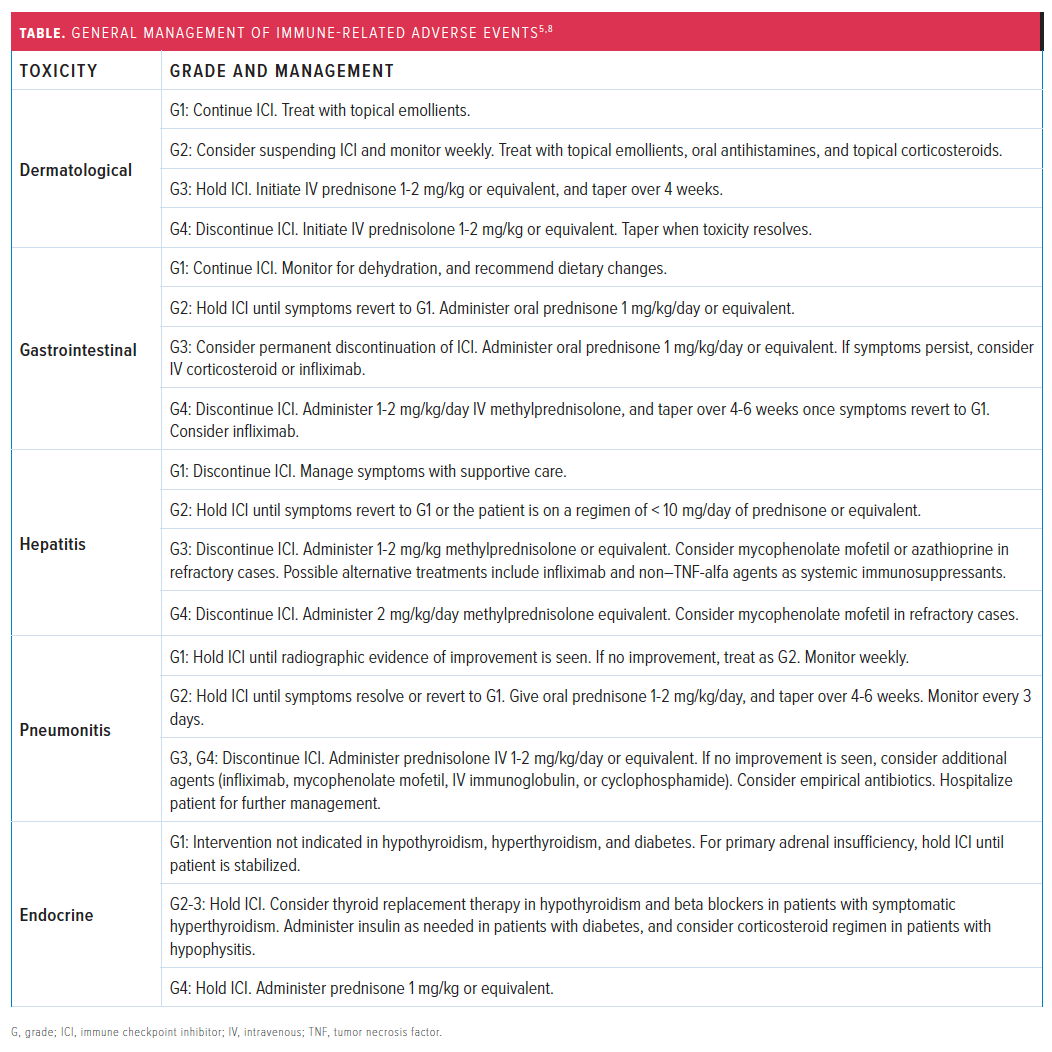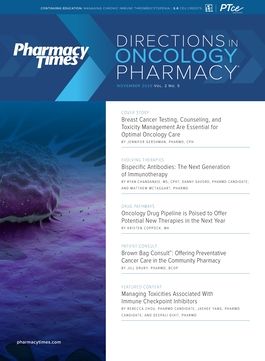Publication
Article
Pharmacy Practice in Focus: Oncology
Managing Toxicities Associated With Immune Checkpoint Inhibitors
Although ICIs have demonstrated excellent efficacy, they also have been associated with unique irAEs.
Immunotheraphy has revolutionized the standard of care for many types of cancers. The first immunotherapy agent was an interferon alpha-2 antitumor cytokine approved in 1986.1 As of 2020, the FDA has approved 35 immunotherapy agents.2,3 Specifically, immune checkpoint inhibitors (ICIs) work by blocking checkpoint pathways that serve to control the human immune response. CTLA-4, PD-1/PD-2, and PD-1L are part of the pathways that downregulate T-cell proinflammatory responses and help cancer cells evade cytotoxic T-cell—mediated death. ICIs augment the human body’s antitumor immunity and tumor surveillance machinery through therapeutic inhibition of these checkpoints.4
Although ICIs have demonstrated excellent efficacy, they have also been associated with unique immune-related adverse events (irAEs), which can be potentially life threatening. Any organ or tissue can be involved, but irAEs most frequently involve dermatologic, gastrointestinal, pulmonary, endocrine, and hepatic systems. Other irAEs such as neurological disorders and myocarditis are rare but may be lethal.5
With the increasing use of ICIs, it is crucial for health care professionals to be knowledgeable on the potential toxicities and their management (TABLE). Moderate to severe irAEs are associated with declines in organ function and quality of life, and they require early detection and proper management, as timely identification and treatment can mitigate complications.6 Close and frequent monitoring of patients is recommended, with a goal of minimizing treatment toxicity and patient outcomes.

Timeline and General Management
The occurrence of irAEs is heterogenous and patient dependent. In general, anti—CTLA-4 therapies have an onset of higher-grade irAEs earlier than anti–PD-1/PD-L1 therapies (with median onset of 6 weeks and 9 weeks, respectively).6 Most irAEs occur early in ICI therapy, usually within weeks to 3 months after initiation. However, irAEs have the potential to occur even after discontinuation of treatment, as late as 1 year afterward.5
The management of irAEs varies depending on the organ system affected and toxicity severity. The severity is quantified using the Common Terminology Criteria for Adverse Events.7
Grades 1 to 2 irAEs are mild to moderate and do not require hospitalization.6 Generally, ICI therapy should be continued for grade 1 toxicities with close monitoring, with some exceptions of neurologic, hematologic, and cardiac toxicities. ICI therapy may be suspended for grade 2 toxicities and should be treated symptomatically. Corticosteroids may be administered, and therapy can be resumed once the symptoms revert to grade 1 or less.8 Grades 3 to 4 irAEs are severe to life threatening. Suspension of ICI therapy is recommended for grade 3 toxicities, and patients generally require high-dose corticosteroid regimens tapered over 4 to 6 weeks. The decision to resume ICI therapy depends on the patient’s tumor response status, although grade 4 toxicities usually warrant permanent discontinuation of ICIs.8
Common irAEs Associated With ICIs
Dermatological irAEs are by far the most frequent toxicity observed from ICI therapy and usually develop within the first few weeks after initiation of the treatment. Low-grade AEs are experienced by nearly 50% of patients taking ipilimumab (Yervoy; Bristol Myers Squibb); however, high-grade AEs are rare. The most frequent dermatologic irAEs are rash and pruritus. Supportive treatment for grades 1 to 2 skin irAEs includes topical emollients, oral antihistamines, and topical corticosteroids. For grades 3 or higher, a dermatology consult and skin biopsy should be considered; ICI therapy should be suspended and intravenous (IV) corticosteroids at an equivalent dose of methylprednisolone 1 to 2 mg/kg/day or equivalent should be initiated with tapering.8
Gastrointestinal (GI) toxicity is the second most common irAE and has been reported in one-third of patients treated with ICI therapy. The onset of symptoms varies greatly depending on the agent.9,10 Grade 1 diarrhea and colitis should be treated symptomatically with antidiarrheals, and ICI should be continued. ICI should be suspended for grade 2 irAEs until symptoms revert to grade 1, and oral corticosteroids should be used at an initial dose of 1 mg/kg/day prednisone or equivalent. When the symptoms advance to grades 3 to 4, patients must be monitored very closely, and IV corticosteroids should be administered at 1 to 2 mg/kg/day methylprednisolone or equivalent. Patients who respond to corticosteroids should be continued on corticosteroids until symptoms improve to grade 1 and then tapered over 4 to 6 weeks.8 If patients are unresponsive or symptoms persist for more than 3 to 5 days, infliximab can be administered unless contraindicated.11
Hepatitis is a subset of GI irAEs and may occur in 5% to 10% of patients on ICIs.5 To minimize toxicity, baseline and serial hepatic function panel, including aspartate aminotransferase, alanine aminotransferase, and bilirubin must be closely monitored before each infusion. For grade 1 hepatitis, the ICI may be continued in addition to increased frequency of hepatic function panel monitoring. For grade 2, the ICI is held temporarily until patients recover to grade 1 or are on a prednisone treatment of less than 10 mg/day or equivalent. The ICI must be held permanently for grades 3 to 4, and corticosteroid treatment should be immediately initiated.8 Other possible treatment options for grades 3 to 4 include mycophenolate mofetil (CellCept; Genentech) and third-line immunosuppressive therapy in those who are refractory to corticosteroids.5
Pneumonitis is one of the rare irAEs, affecting about 10% of those on CTLA-4 agents and 3% of those on PD-1/PD-L1 agents. However, it is the most feared pulmonary complication, as it is one of the most common causes of ICI-related death.6
Any patient who presents with pulmonary symptoms should be assessed immediately, and in the case of grade 2 pneumonitis or higher, an infection must be ruled out by bronchoscopy.5 The time of onset of symptoms tends to be later than that of other irAEs; it is usually 7 to 24 months after initiation of therapy.12 In grades 1 to 2 pneumonitis, ICI therapy should be held and tapered corticosteroids should be initiated over 4 to 6 weeks. In grades 3 to 4 pneumonitis, permanent discontinuation of ICI therapy and hospitalization are required. High-dose IV corticosteroids should be initiated, and if there is no improvement within 2 days, additional immunosuppressive treatment should be added.8
Some common examples of endocrine irAEs include hypothyroidism, hyperthyroidism, primary adrenal insufficiency, hypophysitis, and diabetes.5 Hypophysitis occurs at an incidence of 10% to 17% in patients taking ipilimumab, depending on the dose. Approximately 4% to 10% of patients on anti—PD-1/PD-L1 therapy experience hypothyroidism, and 6.5% of patients taking pembrolizumab (Keytruda; Merck) experience hyperthyroidism.6 For grade 1 hypothyroidism, hyperthyroidism, and diabetes, patients may be able to continue the ICI with close monitoring and follow-up. In cases of grade 1 primary adrenal insufficiency, hypophysitis, and grades 2 to 4 hypothyroidism, hyperthyroidism, and diabetes, hold ICI therapy until the patient is stabilized or is treated effectively for the symptoms.8 Management of endocrine irAEs includes the use of high-dose steroids, beta blockers, and hormone replacement therapy. In diabetic patients, however, the effectiveness of treatment with high-dose steroids is unclear, although all patients treated with ICIs should be monitored regularly for changes in blood glucose levels.5
Although it would be helpful to identify patients at a higher risk for irAEs, the evidence is unclear. Studies have shown that patients with preexisting autoimmune diseases may be safely treated with ICI therapy without exacerbation if cautious monitoring is warranted.13 There is currently no established relationship between the occurrence of irAEs and tumor type or tumor location.8 It may be helpful for providers to use a questionnaire to help recognize the initial stages of irAEs.
Conclusions
As the use of immunotherapy in cancer treatment regimens continues to grow, it is critical that health care providers communicate important information on the immunotherapeutic agents and the possible AEs to patients and caregivers. It is essential that this education occurs before initiation of therapy and continues throughout the duration of treatment. Providers need to emphasize that immunotherapy differs from traditional chemotherapy and, therefore, elicits different responses and AEs that may be unique to each patient.14 It is necessary to monitor the health status even after discontinuation, as agents may continue to influence the immune response.15
Only with communication and transparency throughout the entire health care team can irAEs be prevented and ultimately avoided.
REBECCA ZHOU and JAEHEE YANG are 2022 PharmD candidates at the Ernest Mario School of Pharmacy at Rutgers, The State University of New Jersey.DEEPALI DIXIT, PHARMD, is an associate professor at the Ernest Mario School of Pharmacy and clinical pharmacy specialist, critical care at Robert Wood Johnson University Hospital in New Jersey.
REFERENCES
- Eno J. Immunotherapy through the years. J Adv Pract Oncol. 2017;8(7):747-753.
- Immunotherapy fact of the day #4. Cancer Research Institue. Accessed June 28, 2020. https://www.cancerresearch.org/join-the-cause/cancer-immunotherapy-month/30-facts/04
- Timeline of progress. Cancer Research Institute. Accessed October 8, 2020. https://www.cancerresearch.org/immunotherapy/timeline-of-progress#
- Dine J, Gordon R, Shames Y, Kasler MK, Barton-Burke M. Immune checkpoint inhibitors: an innovation in immunotherapy for the treatment and management of patients with cancer. Asia Pac J Oncol Nurs. 2017;4(2):127-135. doi:10.4103/apjon.apjon_4_17
- Haanen JBAG, Carbonnel F, Robert C, et al; ESMO Guidelines Committee. Management of toxicities from immunotherapy: ESMO Clinical Practice Guidelines for diagnosis, treatment and follow-up. Ann Oncol. 2017;28(supple 4):iv119-iv142. doi:10.1093/annonc/mdx225
- Hyrniewicki AT, Wang C, Shatsky RA, Coyne CJ. Management of immune checkpoint inhibitor toxicities: a review and clinical guideline for emergency physicians. J. Emerg. Med. 2018;55(4):489-502. doi:10.1016/j.jemermed.2018.07.005
- US Department of Health and Human Services, National Institutes of Health, National Cancer Institute. Common Terminology Criteria for Adverse Events (CTCAE), 4.03. NIH. Published June 14, 2010. Accessed October 30, 2020. ttps://evs.nci.nih.gov/ftp1/CTCAE/CTCAE_4.03/CTCAE_4.03_2010-06-14_QuickReference_8.5x11.pdf
- Brahmer JR, Lacchetti C, Schneider BJ, et al; National Comprehensive Cancer Network. Management of immune-related adverse events in patients treated with immune checkpoint inhibitor therapy: American Society Of Clinical Oncology Clinical Practice Guideline. J Clin Oncol. 2018;36(17):1714-1767. doi:10.1200/JCO.2017.77.6385
- Yervoy. Package insert. Bristol-Myers Squibb; 2020.
- Keytruda. Package insert. Merck & Co Inc; 2020.
- Horvat TZ, Adel NG, Dang TO, et al. Immune-related adverse events, need for systemic immunosuppression, and effects on survival and time to treatment failure in patients with melanoma treated with ipilimumab at Memorial Sloan Kettering Cancer Center. J Clin Oncol. 2015;33(28):3193-3198. doi:10.1200/JCO.2015.60.8448
- Friedman CF, Proverbs-Singh TA, Postow MA. Treatment of the immune-related adverse effects of immune checkpoint inhibitors: a review. JAMA Oncol. 2016;2(10):1346-53. doi:10.1001/jamaoncol.2016.1051
- Menzies AM, Johnson DB, Ramanujam S, et al. Anti-PD-1 therapy in patients with advanced melanoma and preexisting autoimmune disorders or major toxicity with ipilimumab. Ann Oncol. 2017;28(2):368-376. doi:10.1093/annonc/mdw443
- Bayer V, Amaya B, Baniewicz D, Callahan C, Marsh L, McCoy AS. Cancer immunotherapy: an evidence-based overview and implications for practice. Clin J Oncol Nurs. 2017;21(supple 2):13-21. doi:10.1188/17.CJON.S2.13-21
- Johnson DB, Friedman DL, Berry E, et al. Survivorship in immune therapy: assessing chronic immune toxicities, health outcomes, and functional status among long-term ipilimumab survivors at a single referral center. Cancer Immunol Res. 2015;3(5):464-469. doi:10.1158/2326-6066.CIR-14-0217







